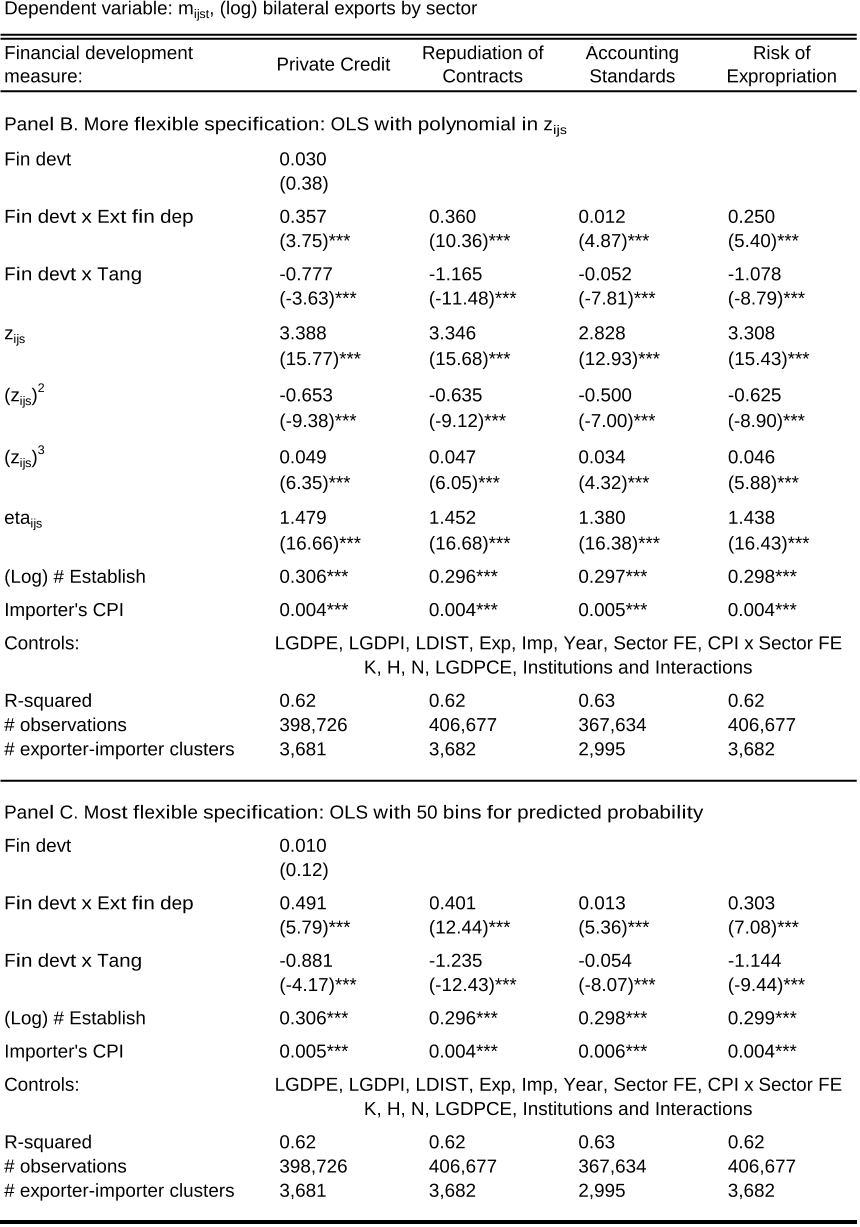Credit Constraints, Heterogeneous Firms and International Trade
Reads0
Chats0
TLDR
This article examined the detrimental consequences of financial market imperfections for international trade and developed a heterogeneous-firm model with countries at different levels of financial development and sectors of varying financial vulnerability.Abstract:
This paper examines the detrimental consequences of financial market imperfections for international trade. I develop a heterogeneous-firm model with countries at different levels of financial development and sectors of varying financial vulnerability. Applying this model to aggregate trade data, I study the mechanisms through which credit constraints operate. First, financial development increases countries' exports above and beyond its impact on overall production. Firm selection into exporting accounts for a third of the trade-specific effect, while two thirds are due to reductions in firm-level exports. Second, financially advanced economies export a wider range of products and their exports experience less product turnover. Finally, while all countries service large destinations, exporters with superior financial institutions have more trading partners and also enter smaller markets. All of these effects are magnified in financially vulnerable sectors. These results have important policy implications for less developed economies that rely on exports for economic growth but suffer from poor financial contractibility.read more
Figures

Table 10. Economic Significance: Predicted vs. Actual Trade Growth 
Table 9. Economic Significance: Comparative Statics 
Table 5. Financial Development and Firm-Level Exports 
Figure 3. The Productivity Cut-off for Exporting 
Table 5. Financial Development and Firm-Level Exports 
Table 1. Export Patterns in the Data
Citations
More filters
Journal ArticleDOI
Trade, farmers’ heterogeneity, and agricultural productivity: Evidence from Colombia
TL;DR: In this article , the authors study how farmers' participation in non-local markets shapes agricultural productivity and find that removing the geographic barriers to farmers’ participation in local markets can increase Colombia's agricultural value added by up to 14%.
Journal ArticleDOI
Tax Reform, Trade Openness and Export Product Diversification in Developing Countries
TL;DR: In this article, the effect of tax reform on export product diversification in developing countries, including through the trade openness channel, was investigated, using a sample of 112 developing countries over the period 1980-2014.
The Extensive Margin in the Industry Trade: Estimation, Signi…cance and Implications
TL;DR: In this paper, the authors decompose the world trade data between three industries (manufacturing, mining and agriculture) and show that the HMR correction should be most prominent for manufacturing trade and less so for the other industries.
Journal ArticleDOI
Marketing and financial barriers in agri-food exporting
TL;DR: In this paper, the authors empirically research marketing and financial export barriers by perceptions of agri-food firms from small developing country with preferential trade position in Europe, using resource-based and contingency theories as framework, differences in barriers perceptions between exporters classified by five organizational factors were tested.
Posted Content
Institutions for Non-Simultaneous Exchange : Microeconomic Evidence from Export Insurance
TL;DR: In this paper, the authors investigate the effects on firm trade, jobs, value added and productivity, using uniquely detailed, comprehensive and longitudinal transaction-level Swedish data on insurance and granular data on exporters and foreign buyers.
References
More filters
Posted Content
Law and Finance
Rafael La Porta,Rafael La Porta,Florencio Lopez de Silanes,Florencio Lopez de Silanes,Andrei Shleifer,Andrei Shleifer,Robert W. Vishny,Robert W. Vishny +7 more
TL;DR: This paper examined legal rules covering protection of corporate shareholders and creditors, the origin of these rules, and the quality of their enforcement in 49 countries and found that common law countries generally have the best, and French civil law countries the worst, legal protections of investors.
Journal ArticleDOI
Law and Finance
TL;DR: In this article, the authors examined legal rules covering protection of corporate shareholders and creditors, the origin of these rules, and the quality of their enforcement in 49 countries and found that common-law countries generally have the strongest, and French civil law countries the weakest, legal protections of investors, with German- and Scandinavian-civil law countries located in the middle.
Journal ArticleDOI
The Impact of Trade on Intra-Industry Reallocations and Aggregate Industry Productivity
TL;DR: This paper developed a dynamic industry model with heterogeneous firms to analyze the intra-industry effects of international trade and showed how the exposure to trade will induce only the more productive firms to enter the export market (while some less productive firms continue to produce only for the domestic market).
Journal ArticleDOI
Finance and Growth: Schumpeter Might Be Right
TL;DR: In this paper, the authors examined a cross-section of about 80 countries for the period 1960-89 and found that various measures of financial development are strongly associated with both current and later rates of economic growth.
ReportDOI
Financial Dependence and Growth
Raghuram G. Rajan,Raghuram G. Rajan,Raghuram G. Rajan,Luigi Zingales,Luigi Zingales,Luigi Zingales +5 more
TL;DR: This paper examined whether financial development facilitates economic growth by scrutinizing one rationale for such a relationship; that financial development reduces the costs of external finance to firms, and found that industrial sectors that are relatively more in need of foreign finance develop disproportionately faster in countries with more developed financial markets.